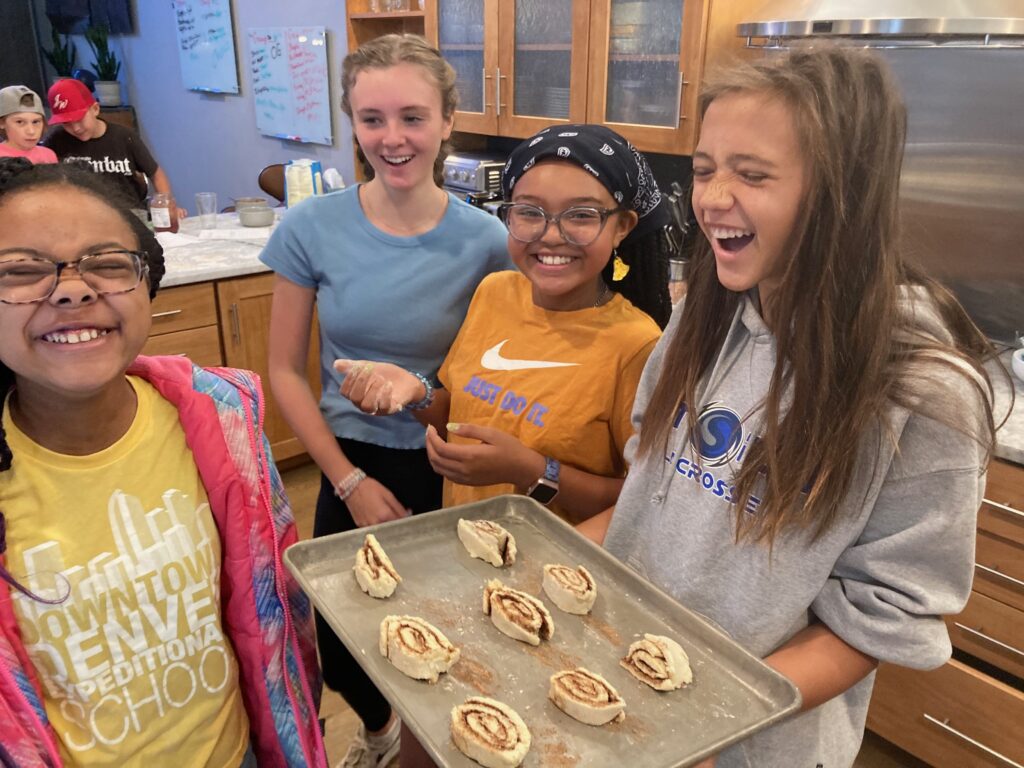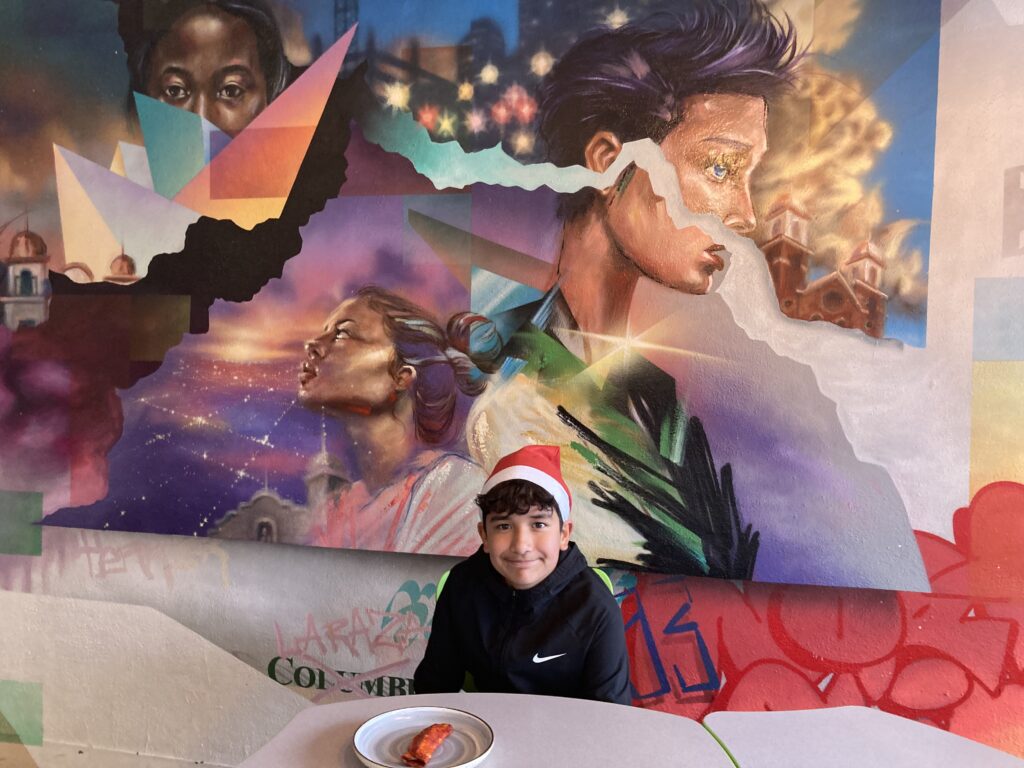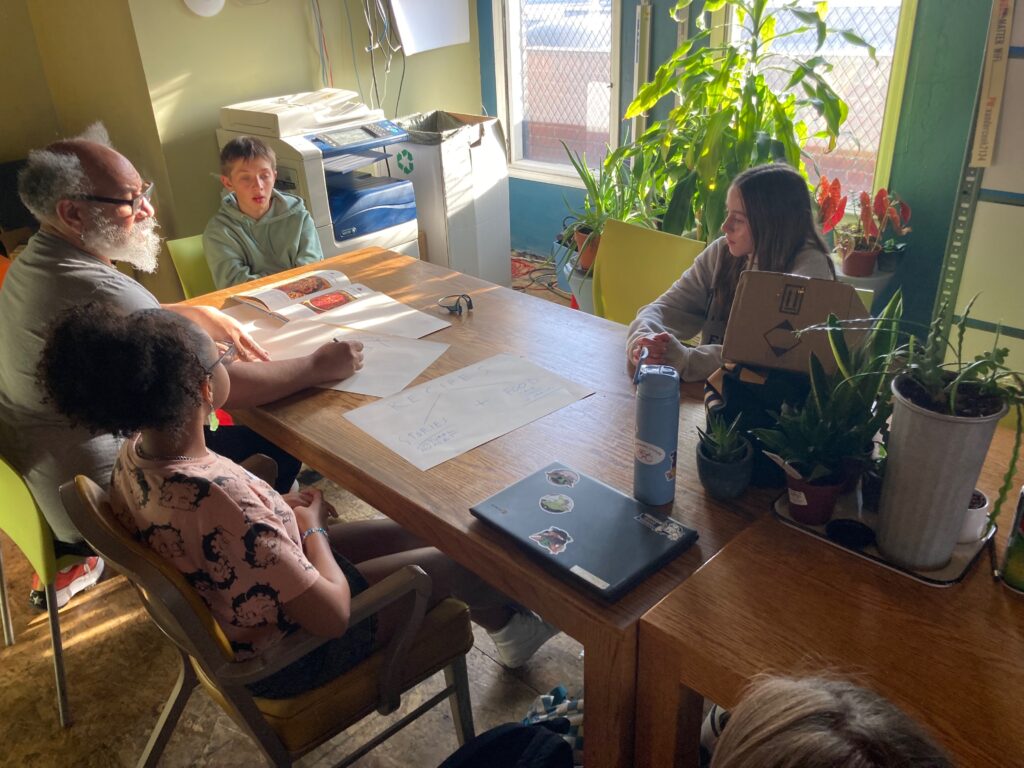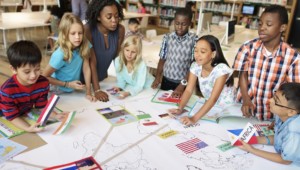How to Co-Design Curriculum: Fostering Inclusivity through Shared Family Narratives
Key Points
-
Discover a learner-centric curriculum at Embark Education, where learners recently co-designed a transformative project centered around family narratives and recipes.
-
Explore the intersection of culinary traditions, empathy, and critical analysis as learners delve into the complexities of cultural revitalization, shifting demographics, and systemic inequities in their communities.
-
Engage with a hands-on approach to competency-based education, culminating in the creation of a culturally rich product in collaboration with local community partners, fostering a deep sense of pride and ownership among learners and their respective communities, alike.

By: Jimmy McCue
Embark Education is a competency-based school driven by the authentic integration of learning in projects at our enterprise, Pinwheel Coffee and co-authored learning experiences. My own collaboration with a group of learners has brought a transformative and deeply personalized dimension to learning. Rather than design and ask my colleagues for feedback through tuning protocols, I co-created a learning experience with learners in an effort to support them as they explore how to courageously inquire, engage, and discover a sense of self. Learners are not only the intended audience of instruction and engagement, but primarily, deserve a space and voice to best target personalized support, realize what is possible for all learners during the course of a project, and manifest more eloquent, nuanced pathways to learning that our adult minds would not have fully devised, appreciated, nor comprehended as possible.
These learners, who have already engaged in empathy exercises, prototyping, and community partnerships throughout the last few months, have selected family recipes that hold special significance to them. As we finish out these last two weeks before winter break, we step back to recognize the intricacies of their cultural and community memories and incorporate these elements into the curriculum to promote diversity, equity, inclusion, and belongingness.
Our project is a collective endeavor, and as the co-designer of this curriculum, I have found inspiration in the diverse backgrounds and experiences of our learners.

Sharing Personal Narratives
In the heart of our journey toward understanding empathy and the power of storytelling, I began by encouraging learners to explore their personal narratives during the inaugural storytelling session, as if we were in Week 1 of the actual project. These stories offered a window into the rich tapestry of their cultural heritage and the enduring presence of their communities. Quickly, the theme of ‘recipes’ began to emerge.
In this collective exploration of cultural memory, our learners were invited to share the stories, which have been passed down through generations. These narratives, steeped in the flavors, aromas, and love of family kitchens, evoked an intense sense of belonging, an understanding of the connection to one’s roots, and a growing awareness of the importance of community in preserving and celebrating our diverse traditions.
I really enjoyed working with people outside of Embark. It was awesome to be a part of the next LE (learning experience) because we hadn’t done that before and we truly got to be a part of the process. One thing that was a challenge was knowing that other learners would be doing this project; it wasn’t just us. This puts a layer of pressure on all of us, but in the end, it feels very successful.
Hazel, 7th grade learner
For these learners, the act of sharing these stories was akin to flipping through the cherished pages of a well-worn family recipe book. These recipes are not mere lists of ingredients and instructions – which, at minimum, would still offer wonderful applications in quantitative reasoning through ratios, proportions, and conversions – rather, they were the vessels of each learner’s cultural history, a testament to the endurance of traditions, and a symbol of the enduring power of food to bring people together.
Just as Grandmas Project beautifully showcases the stories of grandmothers from around the world, our learners brought forth their own family narratives in the ideation phase, revealing the universal importance of food as a means to bridge the gap between generations, cultures, and individuals. It’s in the recipes handed down from mother to child, grandfather to grandchild, that we discovered a shared humanity—a warmth that transcended community borders and various languages.

The NPR article, “Carrying on a Family Recipe in Your Own Way,” exemplified the idea that these recipes are more than just instructions; they’re a living testament to our ability to adapt, innovate, and express our unique identities while still honoring our heritage. Our learners critically evaluated the content of this article, along with several others with similar themes, to seek out a deeper why, apply analysis and critical thinking, and make connections in and outside the classroom.
As a learning facilitator, I actively participated in and guided discussions that were, at times, challenging, such as when addressing the understandable questions regarding changing culinary traditions between themselves and their grandparents, and at other times, revelatory, as was the case when these middle school students were able to consider the macro-level inequities that have historically uprooted generations of families living throughout various neighborhoods of Denver.
Facilitating Critical Analysis
The exploration of historical and systemic inequities briefly introduced above took us on a journey that extended beyond the kitchen and into our very neighborhoods. The diverse perspectives and backgrounds of our learners serve as a foundation to enrich our understanding of how belief systems, policies, and ideologies have transformed over the years, particularly in the context of culinary traditions. Yet, this transformation isn’t isolated; we needed to make the connection with broader societal changes, including issues like gentrification, migration, and shifts in public perception.
As we ventured into the complex terrain of gentrification, we courageously faced the consequences of urban development that have unfolded over decades. Gentrification often occurs when once-neglected neighborhoods experience an influx of wealthier individuals, leading to changes in real estate values, public education, and public perception of neighborhood safety and value. It is understandable to believe that learners at this age cannot fully comprehend the weight of such a topic (or should); yet, I found it essential for them to understand the intricacies of this phenomenon without indoctrination but through factual, illuminating exploration.
To facilitate this exploration, I drew on valuable resources like the New York Times’ interactive guide, which offered insights into how neighborhoods in New York City have evolved. Learners examined data and articles that reveal the shifts in real estate values, population demographics, and the subtle ways marketing strategies have influenced people’s perceptions of various neighborhoods. Furthermore, we introduced the concept of redlining through University of Richmond’s Panorama, which provides a historical context on how discriminatory lending practices in the past have shaped neighborhoods and reinforced racial inequities. This resource offered a concrete example of how systemic racism has had long-lasting impacts on neighborhoods like ours in North Denver. Lastly, we explored urban displacement and its cultural, commercial, and industrial aspects using the data available at the Urban Displacement Project. This allowed learners to grasp how communities have been affected by shifting demographics, changing economies, and redevelopment efforts.
My role as facilitator was to guide our learners through these materials, fostering a balanced and evidence-based understanding of how gentrification and related issues impact communities. By encouraging them to think critically and analyze their own shifts in perspectives, I hoped to empower them to navigate nuanced discussions with empathy and respect for diverse viewpoints. This approach enabled learners to make informed connections between their personal experiences and the broader theme of inclusivity, and additionally, equip them with the tools to critically evaluate societal changes in their neighborhoods. Ultimately, the achieved goal was to instill a sense of agency in our learners to participate in creating more equitable and just communities for the future.
Collaboration in Cookbook Creation
Our journey in creating a cookbook that encapsulates the cultural richness and diversity of our learners’ family recipes took an exciting turn as we developed a continued partnership with the Shop at Matter, an independent, Black- and woman-owned design consultancy, letterpress workshop, and bookstore that uses joy and love as acts of resistance. This collaboration amplified the value of our project, adding an enriching layer to our exploration of communication competencies and the art of storytelling through food.

The learners actively engaged in the cookbook creation process, drawing on their experiences and personal connections to the chosen family recipes. As the project unfolded, learners were given the unique opportunity to delve into the history and significance of these recipes, and to share them with a wider audience, fostering a deep sense of pride and ownership. How did we plan to do this during the actual project? We drew inspiration from Ladson-Billings’ vision of parent “artist or craftspersons-in-residence” as outlined in But That’s Just Good Teaching! The Case for Culturally Relevant Pedagogy. Recognizing the invaluable contributions parents can make to the educational experience, our co-design journey extended to anticipation invitations to parents to be integral members of the educator team. This collaborative endeavor aligned with the collective vision of creating a more inclusive and diverse learning environment.
In implementing this offering, we explored a commitment during the project to promote racial literacy, utilize inclusive language, and provide virtual options to ensure broader and more accessible participation. Acknowledging the importance of diverse perspectives, we wanted to create a space where parents could share their unique skills, knowledge, and experiences, contributing to the rich tapestry of this learning experience. This approach not only aligns with Ladson-Billings’ framework, but also emphasizes the principles of equity, inclusion, and embracing the varied expertise that parents bring to the educational journey.
As we contacted and developed partnerships with local culinary academics and community kitchens, learners found themselves hands-on in the process of crafting and documenting these recipes. This approach ensured the authenticity and accuracy of the cookbook, from ingredient lists to cooking instructions. As they kneaded, stirred, and sizzled, learners not only gained culinary skills instructed through the expert knowledge of older family members and community members, but also a profound understanding of the cultural and historical contexts that infuse each recipe. This hands-on experience not only fostered a sense of empowerment but also provided the communication competency of “developing ideas,” as learners gathered insights from their research and shared the cultural and historical context behind each dish.
In the realm of communication competencies, our project’s additional goal is to emphasize the process of learning, not just the end result. The “organize thoughts” competency was honed as learners sequenced ideas, evidence, and events to create a coherent narrative within the cookbook. Varied transitions helped connect the rich stories and origins behind each recipe, making the book an engaging read. Learners also grasped the significance of crafting logical introductions and conclusions that offer insight into the cultural significance and implications of each dish.

The “Use Language” and “Address an Audience” competencies were intertwined as learners mastered the art of selecting the right words and tone to convey the essence of each recipe. Naturally, their audience ranges from fellow learners to a broader community eager to explore diverse culinary traditions. Thus, they understood the importance of adapting their language and style to cater to the purpose, task, and audience. Given that we’re living in a digital age whose language is best understood by learners of this age group, they also utilized various media tools to effectively share their stories, justifying their choice of medium to reach their audience. As a result, the presentation and product supported audience engagement and understanding, allowing their culinary narratives to come alive. Lastly, the “Deliver a Message” competency involves using verbal and nonverbal language to interact with an audience effectively. In the last few weeks, learners presented their dishes with passion and authenticity, incorporating appropriate body language and speaking skills to engage their audience. This was top of mind in a reflection by Mark Gabriel, Director of Adult Learning Experiences at Embark Education, after experiencing the aforementioned workshop with What School Could Be: “Experts in their field were being taught about learner-centered education by our learners and while it was so impressive, it was like the learners didn’t even realize how amazing their work was because it is so natural to them. It really showed how special Embark is!”
Learner’s Role in Transformative Learning

At Embark Education, I’ve discovered that the magic unfolds when learners actively shape their educational experiences, fostering inclusivity through shared narratives. Below, I offer a generalizable step-by-step process to begin a journey where students take the lead in crafting a personalized, nuanced, and deeply meaningful learning adventure. Finally, be sure to look for a follow-up article after this project’s completion in February, as I’m excited to unveil this project with our whole learning community!
Step 1: Embrace Student-Centric Integration
Encourage learners to actively contribute to the curriculum design, tapping into their diverse backgrounds and experiences. In our co-design project, learners brought forth their unique perspectives, shaping a project that reflected their collective vision and interests. Josh Reppun reflected on this phase of the process, noting, “As the host of the What School Could Be Podcast, and now with 117 episodes under my belt, I have heard what feels like hundreds of incredible examples of real world, student-driven learning. This Embark family recipe project just might take the cake, no pun intended. The extent to which Jimmy’s students have taken the learning deep into their communities is truly remarkable. They embarked on a journey together that will surely resonate over their entire collective lifetimes. What a gold star example of deeper learning!”
Step 2: Unlock Personal Narratives Through Storytelling
Initiate a journey toward empathy and storytelling by prompting learners to delve into their personal narratives. Family recipes, as showcased in our project, became a powerful tool to connect learners to their cultural heritage, community, and shared human experiences. Adam Haigler, Co-founder and COO of Open Way Learning, has been a close mentor and friend throughout my time as an educator, which has led me to this second step. In fact, my developing competency in this educational approach is due to his insight and guidance, believing that culturally revitalizing and place-based education “is the perfect vehicle to explore our respective places. The ingredients of the instructional model encourage us to explore our communities, bring in authentic contexts, and present our findings publicly. The intersection between co-designed learning experiences and place-based learning is a natural fit.” When I asked him how he would lead a similar co-design exercise with learners, he responded, “We do this by first asking what makes our place unique and what problems our students might be able to solve around us. We use co-designed projects as the model that structures our exploration and helps us build toward significant contributions to the community with the authentic context it provides. Co-designing with students pushes us to create a collaborative culture and the community becomes a key collaborator.”
Step 3: Cultivate a Tapestry of Perspectives
Transform your curriculum by recognizing the significance of personal narratives beyond cultural boundaries. Just as in our project, where family recipes became a celebration of diversity, consider incorporating elements that resonate universally, fostering a rich tapestry of perspectives.
Step 4: Facilitate Inclusive Discussions
Take on the role of a co-facilitator, allowing learners to lead discussions on inclusivity, diversity, equity, and belonging. In our project, this step brought authenticity to our conversations, allowing learners to reflect on their identities within the broader context of DEIB. As Jennifer D. Klein noted throughout our preparation and virtual educator workshop, “I loved being part of students’ growth when it came to engaging new audiences with their ideas and learning. The first time we met virtually, it took a little while for learners to open up and share more than just a word or two. As Jimmy drew them out with questions and encouragement, and as I modeled transparency and vulnerability myself, they leaned into sharing more about their narratives and experiences. Everyone who attended our later event on What School Could Be noted that it was like being in on a conversation among students who were fully empowered—not just to follow their teacher’s lead, but to follow their own sense of purpose, which was beautifully grounded in who they are and the neighborhood they’ve grown up in.”
Step 5: Venture into Critical Analysis Beyond Subject Boundaries
Extend your exploration beyond the subject matter, engaging learners in critical analysis. Utilize real-world issues, as we did in our project, to empower learners to think critically and analyze societal changes. This approach is adaptable to a wide range of subjects.
Step 6: Foster Collaborative Creation
Elevate your project by encouraging collaboration, potentially through partnerships with local businesses or organizations. In our experience with the Shop at Matter, this collaboration enriched our exploration of communication competencies, adding a layer of real-world application to our project. As the shop owner, Rick Griffith, noted, “Learning what’s important to the young people we’re working with and actively incorporating their ideas into this project is really important to building trust as a primary currency in learning (and teaching in systems) that I don’t take for granted. It’s with these small amounts of trust that we can get the active participation of more young people in their experience. This is both exciting and deeply moving for me.”
Step 7: Personalize Learning with a Real-World Touch
Insert yourself into the curriculum to enhance the learning experience and promote broad principles. Facilitate discussions on privilege and equity, engage in critical analysis of various perspectives, and inspire civic engagement. Your journey and experiences serve as valuable assets in creating a vibrant and inclusive learning environment.
Jimmy McCue is an Educator at Embark Education.







0 Comments
Leave a Comment
Your email address will not be published. All fields are required.